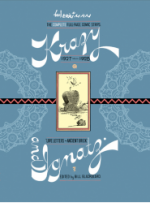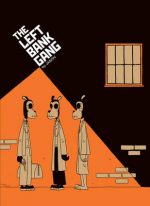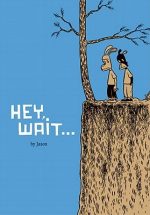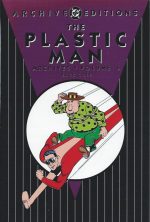
By George Herriman, edited by Bill Blackbeard (Fantagraphics Books)
ISBN: 978-1-56097-507-6
The cartoon strip starring Krazy Kat is quite possibly the pinnacle of graphic narrative innovation; a hugely influential body of work which shaped the early days of the comics industry and became an undisputed treasure of world literature.
Krazy and Ignatz (as it is dubbed in these fabulous commemorative tomes from Fantagraphics) is a creation which can only be appreciated on its own terms. Over its many years of abstracted amazement the series gradually developed a unique language – at once both visual and verbal – whilst abstrusely exploring the immeasurable variety of human experience, foibles and peccadilloes with unfaltering warmth and understanding and without ever offending anybody… except a few local newspaper editors…
Sadly, however, it certainly baffled far more than a few…
Krazy Kat was never a strip for dull, slow or unimaginative people who simply won’t or can’t appreciate the complex multilayered verbal and pictorial whimsy, absurdist philosophy or seamless blending of sardonic slapstick with arcane joshing. It is still the closest thing to pure poesy that narrative art has ever produced.
Herriman was already a successful cartoonist and journalist in 1913 when a cat and mouse who had been cropping up in his outrageous domestic comedy strip The Dingbat Family/The Family Upstairs graduated to their own feature. Krazy Kat debuted in William Randolph Hearst’s New York Evening Journal on Oct 28th 1913 and – largely by dint of the publishing magnate’s overpowering direct influence and interference – gradually spread throughout his vast stable of papers.
Although Hearst and a host of the period’s artistic and literary intelligentsia (notably – but not exclusively – e.e. Cummings, Frank Capra, John Alden Carpenter, Gilbert Seldes, Willem de Kooning, H.L. Mencken and others) all adored the strip, many regional editors did not; taking every potentially career-ending opportunity to drop it from the comics section.
Eventually the feature found a home and safe haven in the Arts and Drama section of Hearst’s papers. Protected there by the publisher’s heavy-handed patronage, the Kat flourished unharmed by editorial interference and fashion, running generally unmolested until Herriman’s death in April 1944.
The basic premise is evergreen and deceptively simple: Krazy is an effeminate, dreamy, sensitive and romantic feline of indeterminate gender hopelessly in love with rude, crude, brutal, mendacious and thoroughly scurrilous Ignatz Mouse. It’s the old story of opposites attracting but here the oodles of affection are unreciprocated and the love is certainly only going one way…
Ignatz is a true unreconstructed male; drinking, stealing, fighting, conniving, constantly neglecting his wife and children and always responding to Krazy’s genteel advances by clobbering the Kat with a well-aimed brick (obtained singly or in bulk from noted local brick-maker Kolin Kelly) which the smitten kitten invariably and inexplicably misidentifies as tokens of equally recondite affection.
The third crucial element completing an anthropomorphic eternal triangle is lawman Offissa Bull Pupp, who is completely besotted with Krazy, professionally aware of the Mouse’s true nature, yet hamstrung – by his own amorous timidity and sense of honour – from removing his diabolical and un-reconstructable rival for the foolish feline’s affections.
Krazy is, of course, blithely oblivious to Pupp’s dilemma…
Collaboratively co-populating the ever-mutable stage are a stunning supporting cast of inspired bit players such as dreaded deliverer of unplanned, and generally unwanted, babies Joe Stork; wandering hobo Bum Bill Bee, unsavoury conman and trickster Don Kiyoti, busybody Pauline Parrot, self-aggrandizing Walter Cephus Austridge, inscrutable – often unintelligible – Chinese mallard Mock Duck, dozy Joe Turtil and a host of other audacious characters, all equally capable of stealing the limelight and even supporting their own features.
The exotic, quixotic episodes occur in and around the Painted Desert environs of Kokonino (based on the artist’s vacation retreat in Coconino County, Arizona) where surreal playfulness and the fluid ambiguity of the flora and landscape are perhaps the most important member of the cast.
The strips themselves are a masterful mélange of unique experimental art, wildly expressionistic and strongly referencing Navajo art forms whilst graphically utilising sheer unbridled imagination and delightfully evocative lettering and language: alliterative, phonetically and even onomatopoeically joyous with a compelling musical force (“Soff, soff brizzâ€, “l’il dahlink†or “Ignatz, ware four is thou at Ignatz??â€).
Yet for all that, the adventures are poetic, satirical, timely, timeless, bittersweet, self-referential, fourth-wall bending, eerie, idiosyncratic, astonishingly hilarious escapades encompassing every aspect of humour from painfully punning shaggy dog stories to riotous, violent slapstick. Oft times Herriman even eschewed his mystical meandering mumblings and arcane argots for the simply sublime grace of a silent gag in the manner of his beloved Keystone Cops…
There have been numerous Krazy Kat collections since the late 1970s when the strip was rediscovered and reclaimed by a better-educated, open-minded and far more accepting audience.
This tantalising tome – covering 1927-1928 in a comfortably hefty (231 x 15 x 305 mm) monochrome softcover edition as always offers added value as context, background and other cartoon treats are delivered by the much-missed Bill Blackbeard in his puckish Introduction essay of short informational snippets ‘Pilfering Mrs. Kwak-Wak’s Good Old Goods and Goodies Bag’
Here press clippings of a near-death experience for Herriman and fellow strip man Jimmy Swinnerton are re-presented beside early gag pages such as Embarrassing Moments and excepts from Hearst Joke Book editions of The Dingbats. Also included are a wealth of strips by Herriman’s contemporaries, rivals and plagiarists…
On to the strips then: within this compelling chronicle of undying amours utterly unhorsed by smirking Fate, the perpetual play unfolds as always but with some of those intriguing supplementary characters increasing coming to the fore.
We open with the change of years bringing weeks’ worth of seasonal disorders and sartorial shenanigans as Krazy further pursues that dream of a singing career. Ignatz, meanwhile, hunts for the perfect projectile which over and again draws him into the clutches of mountebanks, charlatan and magicians…
That search for ammunition leads to many more brick-based broadsides but these days Bull Pupp is far wiser to the Mouse’s modus operandi…
An occasional strictly visual pun session plays well against the numerous slapstick antics, even as Ignatz devises ever-more convoluted ways to bounce his bricks off the Kat’s bean whilst the weird landscapes and eccentric elemental conditions increasingly add to the humorous inspiration with apocryphal wind witches and snow squaws making their invisible presences felt…
Recurring cousins Krazy Katfish and Krazy Katbird pop up to muddy the romantic waters, whilst Kat and Mouse frequently indulge in the growing freedom of the skies and waterways via balloon and other aeronautical apparatus or maritime machine.
Joe Stork continues to divide his time between the delivery of (generally unwanted) babies and other, less legal packages and there’s a many a jest regarding the total illegality of easily obtained hooches and fire-waters…
As the years progress Ignatz spends ever-longer periods in jail yet seldom fails to find a way to deliver the punishing skull blows Krazy yearns for…
Many cast members become obsessed with being struck by lightning and other electrical intercessions, but the biggest surprise is undoubtedly a time-warping origin sequence which carries us back to the obscure infancies of Krazy, Ignatz and Bull…
There are more wandering wonderments as certain elephantine geological features again take up unescorted perambulation and the county even catches a touch of meteor fever as the landscape is beset by falling stars and fiery flotsam from space.
The year again concludes with uncharacteristic chills and spills as Kokonino is subjected to squalls of snow but worst of all is a plague of politicians, prophets and preachers all proselytising on the path to peace, forcing the residents make their feelings acrimoniously clear…
…And always plain mischief rules, whenever Herriman pictorially plays hob with the laws of physics, just to see what will happen…
Wrapping up the cartoon gold is a peek at one of the earliest and rarest of merchandising items – a 1920s wooden Ignatz doll – as well as another erudite and instructional ‘Ignatz Mouse Debaffler Page’ (providing pertinent facts, snippets of contextual history and necessary notes for the young and potentially perplexed). One final fillip is a selection of out-of-sequence replacement pages plus a sequence of pertinent daily strips which tie into the regular run of Sundays collected here…
Herriman’s epochal classic is a phenomenal achievement: in all the arenas of Art and Literature there has never been anything like these comic strips which have shaped our industry and creators, inspiring auteurs in fields as disparate as prose fiction, film, dance, animation and music, whilst delivering delight and delectation to generations of wonder-starved fans.
If, however, you are one of Them and not Us, or if you haven’t experienced the gleeful graphic assault on the sensorium, mental equilibrium and emotional lexicon thrown together by George Herriman from the dawn of the 20th century until the dog days of World War II, this companiable compendium is a most accessible way to do so. Heck, it’s even available as an eBook now so don’t waste the opportunity…
© 2002, 2008 Fantagraphics Books. All rights reserved.











